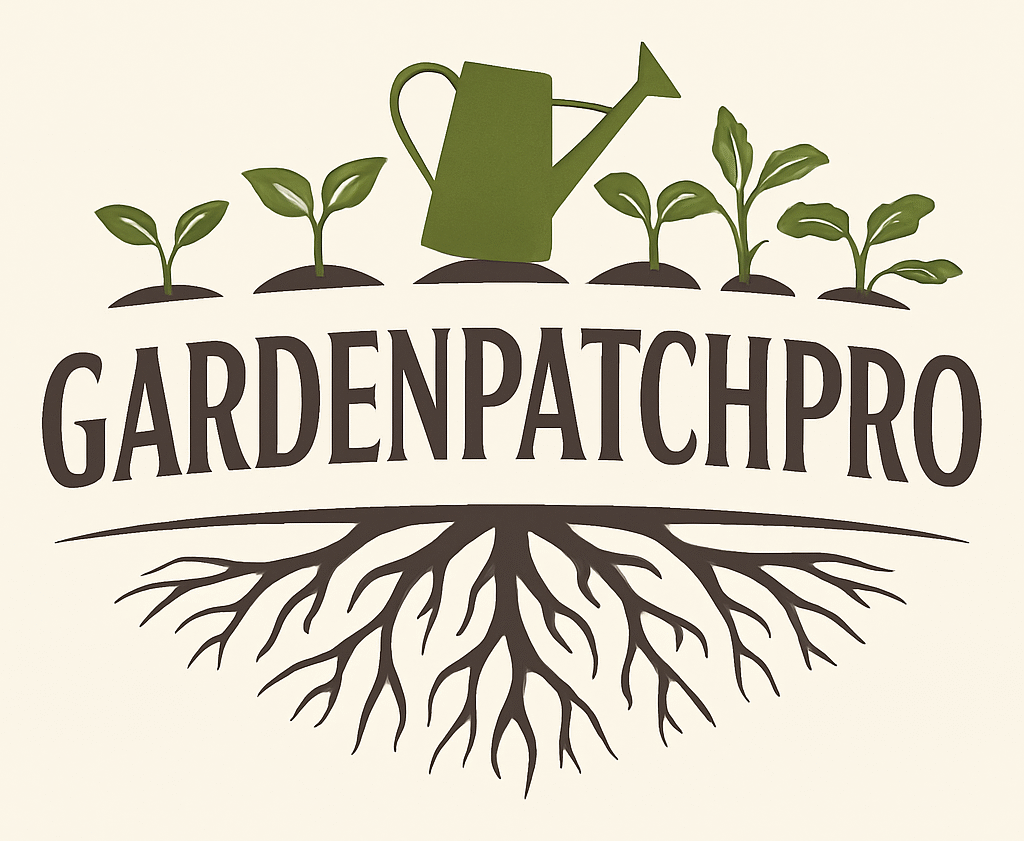16 Hydroponic Gardening Ideas for Maximizing Space and Yield
Hydroponic gardening offers a way to grow plants without soil, using nutrient-rich water instead. It is becoming more popular for those who want to save space or garden indoors. This method allows people to cultivate a wide range of plants efficiently.

Hydroponic gardening ideas provide practical ways to set up and maintain these soil-free systems, making it easier to grow fresh herbs, vegetables, and flowers at home. These ideas can help both beginners and experienced gardeners find new ways to improve their growing space and increase yields.
1) NFT Hydroponic Tower System
The NFT (Nutrient Film Technique) hydroponic tower system is a popular way to grow plants vertically. It uses a thin film of nutrient-rich water that flows over plant roots inside a vertical structure. This keeps roots moist while giving them enough oxygen.
The tower design saves space and allows growers to harvest fresh produce year-round. It works well for leafy greens, herbs, and small vegetables. The vertical layout also makes it easier to manage and monitor plants.
Building an NFT hydroponic tower often involves simple materials like PVC pipes or plastic tubes. Pumps move the nutrient solution through the system continuously. This keeps plants fed without needing soil.
This system is favored for being efficient and sustainable. It uses less water than traditional gardening since it recycles nutrients. Those who want to start at home can find step-by-step guides and tips for setting up a DIY NFT hydroponic tower system online. For detailed instructions, see this guide on building a vertical NFT system.
2) DIY PVC Pipe Hydroponic Garden

A DIY PVC pipe hydroponic garden uses PVC pipes as the main structure for growing plants without soil. The pipes are durable, easy to handle, and affordable. This makes them a popular choice for building simple, space-saving hydroponic systems.
The design often involves drilling holes into the pipes where plants are placed. Nutrient-rich water flows through the pipes, feeding the plants directly. This method uses less water than traditional gardening and can be set up indoors or outdoors.
Building this system requires basic tools like a drill, PVC pipes, a water pump, and a nutrient solution. Regular monitoring of the water and nutrients is important to keep the plants healthy.
DIY PVC hydroponic gardens allow growing fresh vegetables and herbs year-round. They offer an effective way to grow food in small spaces while reducing soil use. For step-by-step guides and tips, detailed instructions can be found in a DIY hydroponic garden tower using PVC pipes.
3) Kratky Method Container Garden
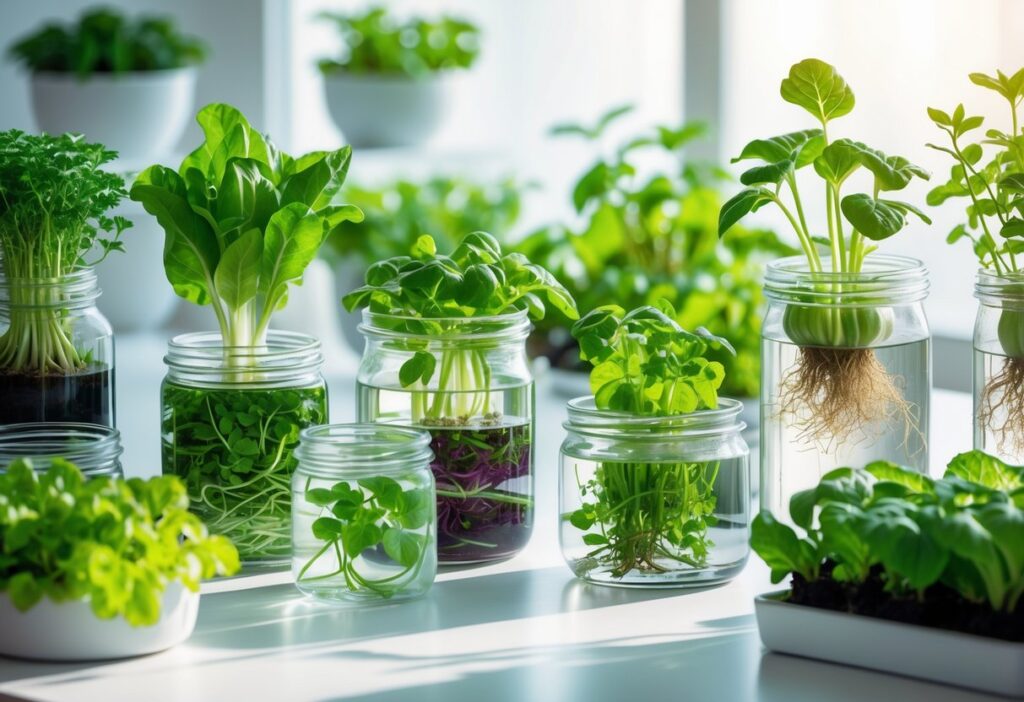
The Kratky Method is a simple way to grow plants without soil. It uses a container filled with nutrient-rich water. Plants sit above the water, with roots growing down into it to absorb nutrients.
Choosing the right container is important. Glass jars like mason jars are common, but any suitable-sized container works well. It should hold enough water to support the plants until harvest without refilling often. Containers can be glass, plastic, or other materials, as long as they fit the plant size and setup.
This method is low maintenance and does not need pumps or electricity. It works best for leafy greens and herbs, which grow quickly in about a month. The container garden is ideal for small spaces and beginners. It offers a hands-off approach while still providing fresh, homegrown produce.
More details about selecting containers and setup tips are available in this guide on the best containers for the Kratky Method.
4) Floating Raft System

The floating raft system is a popular hydroponic method where plants grow on a floating platform. Their roots hang directly into nutrient-rich water below. This design allows easy access to nutrients and oxygen, which supports healthy growth.
It is simple to build and maintain. The platform is usually made of Styrofoam or other buoyant materials that keep plants stable on the water surface. This system works well for leafy greens and herbs.
Water is continuously circulated in the system, improving nutrient uptake by plants. It uses less water than soil gardening because the water is reused. This also helps reduce waste and conserve resources.
The floating raft system is efficient and can deliver consistent yields. It is often recommended for beginners because of its straightforward setup and low operating costs. Many growers expand their hydroponic gardens using this method.
More detailed steps on building a floating raft system can be found in the guide on how to build a big floating raft hydroponics system.
5) Nutrient Film Technique (NFT) Setup

The Nutrient Film Technique (NFT) is a popular hydroponic method ideal for growing leafy greens and herbs. It uses a shallow stream of nutrient-rich water that flows over plant roots in a sloped channel. This keeps roots moist and oxygenated.
To set up an NFT system, one needs sloped grow channels, a reservoir for nutrient solution, a water pump, and net cups to hold the plants. The nutrient solution flows continuously, providing plants with water and nutrients.
This setup is efficient because it uses less water than traditional methods. It also promotes fast growth and reduces the chance of root rot. However, a steady pump and correct slope are important to keep the nutrient film flowing properly.
Beginners should monitor the nutrient levels closely and adjust them as plants grow. For detailed instructions on building an NFT system, it is helpful to refer to an NFT hydroponic setup guide.
6) Aeroponic Cloner Frame

An aeroponic cloner frame is designed to hold plant cuttings in place while their roots grow in a misted environment. The frame usually suspends the plants’ stems and leaves above a container where the roots hang freely. This setup allows the roots to receive oxygen and nutrient mist regularly.
The frame can be made from materials like PVC pipes or plastic boards with evenly spaced holes. These holes hold net pots or collars that support the cuttings securely. The design keeps the plant bases in the air while misting pumps deliver nutrient-rich water to the roots.
Using an aeroponic cloner frame helps reduce water use compared to traditional soil cloning. It also lowers the risk of disease because the roots stay clean and well oxygenated. The frame can be customized to fit different plant sizes and cloning quantities.
Building your own aeroponic cloner frame can be cost-effective and tailored to specific needs. Step-by-step guides offer practical advice on creating a reliable frame with good airflow and easy access for maintenance. More details about building aeroponic cloners are available from hydroponichorizons.com.
7) Ebb and Flow Flood Table

The Ebb and Flow flood table is a popular hydroponic system. It works by flooding the plant roots with nutrient-rich water, then draining it away. This cycle repeats several times a day, giving plants water, oxygen, and nutrients.
This system is simple and cost-effective. It uses a water pump to control flooding and draining, making it easy to automate. It is also flexible and can support different plant sizes and growing media.
Many growers like it for herbs, vegetables, and flowers. The flood table lets roots breathe between watering cycles, which helps prevent root rot. It requires some setup but offers reliable results.
A DIY ebb and flow system can be built with basic materials and simple steps. Knowing how to set up the system and maintain pH and nutrient levels is key to success. For a guide on building an ebb and flow system, check this DIY Ebb and Flow system guide with flood tables.
8) Deep Water Culture (DWC) Bucket

Deep Water Culture (DWC) uses a bucket filled with nutrient-rich water to grow plants. The plant roots hang directly in this oxygenated water. This method provides constant access to nutrients and water.
The bucket usually has an air stone connected to an air pump. This keeps the water oxygenated so the roots can breathe. Proper oxygen helps plants grow faster and develop stronger roots.
DWC buckets are simple, affordable, and easy to maintain. They work well for leafy greens, herbs, and some fruiting plants. Monitoring water levels and pH is important to keep the nutrient balance right.
Building a DWC bucket system only needs a few materials like a bucket, net pot, air pump, and tubing. It can be set up indoors or outdoors with limited space.
For detailed instructions on how to make a DWC bucket at home, this guide on how to make a DWC bucket for optimal plant growth is useful.
9) Hydroponic Herb Garden Kit

A hydroponic herb garden kit offers a simple way to grow fresh herbs indoors. These kits come with all the basic components needed for hydroponic growing, such as water reservoirs, growing pods, and sometimes LED lights to support plant growth.
They are designed for easy setup and low maintenance, making them suitable for beginners. Many kits include self-watering systems, which help keep the herbs hydrated without frequent attention.
The compact size of these kits fits well on windowsills or small countertops, making fresh herbs accessible year-round. They often allow growing multiple varieties of herbs at once, like basil, mint, or parsley.
Hydroponic herb garden kits are practical for people with limited outdoor space or those wanting to grow herbs all year. Some kits also feature adjustable lights to ensure plants get enough energy indoors.
For more information on hydroponic herb garden kits, explore this guide on the best indoor hydroponic herb garden kits for fresh herbs all year.
10) Self-Watering Hydroponic Planter

A self-watering hydroponic planter supplies water and nutrients automatically to plants. It uses a reservoir that refills the growing medium when levels drop. This system helps keep plants hydrated without daily watering.
These planters combine hydroponics with automated watering, reducing the risk of over- or underwatering. They work well for people who want low-maintenance gardening.
Many DIY versions use recycled bottles or simple containers to create a self-watering effect. The top part holds the plant while the bottom stores the nutrient solution.
This setup offers consistent moisture and nutrient delivery, which supports steady plant growth. It is especially useful indoors or in areas where regular watering is difficult.
For step-by-step guides and ideas on making these planters at home, there are several helpful resources like the self-watering hydroponic planter box guide available online.
11) Compact Desktop Hydroponic Unit
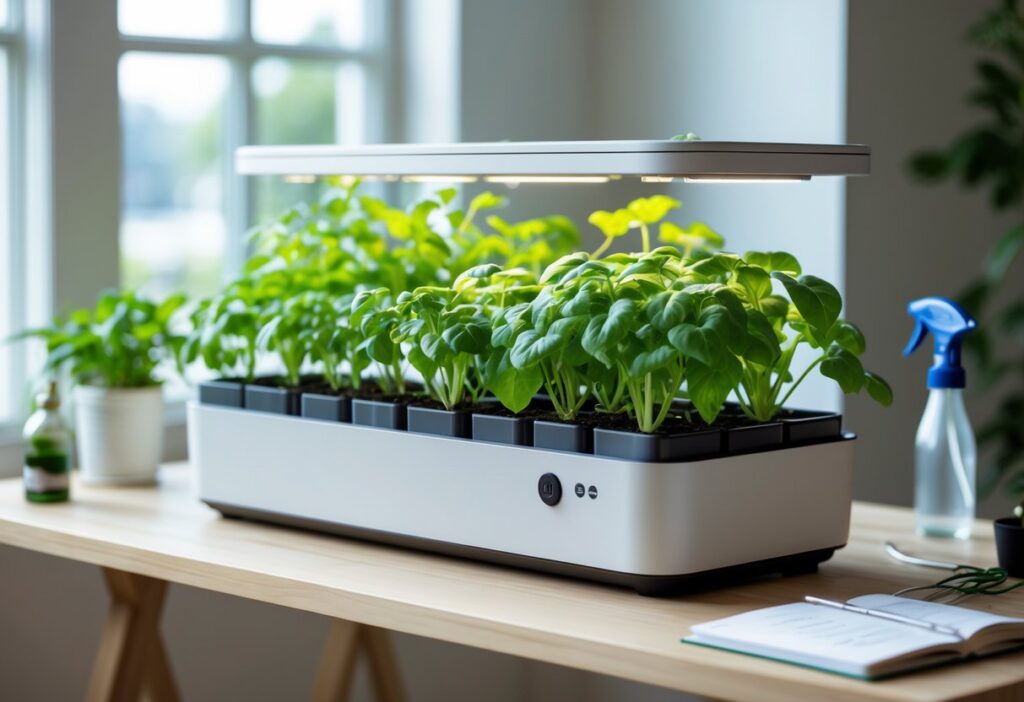
A compact desktop hydroponic unit is ideal for small spaces like offices or apartments. It allows people to grow fresh herbs and greens right on their desk without soil.
These units use water and nutrients to feed plants, which means less mess and easier care. Many models come with built-in LED lights to support plant growth indoors.
They are low-maintenance and can fit on any flat surface. This makes them a good choice for beginners or anyone wanting fresh produce without a garden.
Some units have automated systems that control watering and lighting. This feature helps keep plants healthy even if the user forgets to check them regularly.
To learn more about the options and benefits of these small systems, see the list of 15 best desktop hydroponic kits for growing fresh greens at home.
12) Vertical Hydroponic Wall Garden

A vertical hydroponic wall garden uses vertical space to grow plants without soil. This method is ideal for small areas like apartments or patios. It allows many plants to be grown in a compact, organized way.
The system often uses a wooden frame, PVC pipes, or repurposed shelves to hold plants. Nutrient-rich water flows through the setup, feeding plants directly at their roots. This keeps the garden clean and efficient.
It is common to grow herbs like basil, mint, or small vegetables. These plants can thrive when stacked vertically and cared for properly. Vertical gardens also add greenery to indoor or outdoor walls.
Maintaining a vertical hydroponic garden requires regular monitoring of water and nutrients. Proper lighting is also important to support healthy plant growth. With good care, this garden style can produce fresh, edible plants in limited space.
For detailed ideas and examples, see DIY vertical hydroponic ideas to grow food.
13) Hydroponic Mushroom Cultivation

Hydroponic mushroom cultivation is a method of growing mushrooms without soil. Instead, mushrooms grow on a nutrient-rich water solution or alternative media. This setup allows better control over moisture and nutrients.
Mushrooms do not have roots like plants, so hydroponics suits them well. They often grow faster and larger in these systems compared to traditional soil methods. This can lead to higher yields and improved quality.
Maintaining the right temperature, humidity, and light is important for successful growth. Growers often use mushroom kits or create custom hydroponic setups to meet these needs.
Hydroponic mushroom farming can be done year-round. It offers a clean and efficient way to produce fresh mushrooms at home or commercially.
For detailed guidance, there are many resources available on hydroponic mushroom growing techniques and care. More information can be found at Hydroponic Mushrooms: Growing Mycelium Without Soil.
14) Medicinal Plant Hydroponic Setup
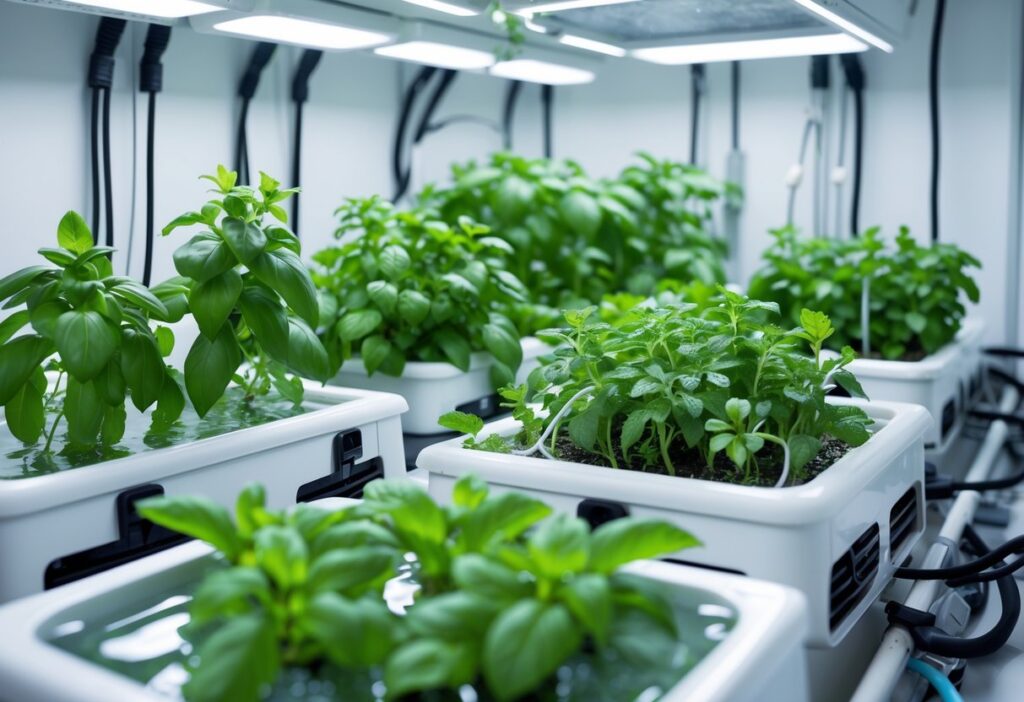
A medicinal plant hydroponic setup uses water and nutrients instead of soil to grow herbs with healing properties. This method controls growing conditions like light, temperature, and nutrients. It helps plants grow faster and may increase their potency.
Setting up requires a clean system with a nutrient solution tailored to the plants’ needs. Common growing mediums include coconut coir or rockwool to support roots. Proper lighting, usually LED, is essential for steady growth indoors.
Maintaining pH levels and nutrient balance is critical. Regular monitoring prevents nutrient deficiencies and keeps plants healthy. Hydroponics also reduces pest problems and saves water compared to traditional gardening.
This setup works well for plants like lavender, chamomile, and peppermint. They can thrive year-round in a controlled environment. Learning how to manage nutrients, lighting, and watering can lead to a successful medicinal herb garden at home.
More detailed guides on setting up can be found in resources about growing medicinal plants hydroponically.
15) Exotic Fruit Hydroponic System
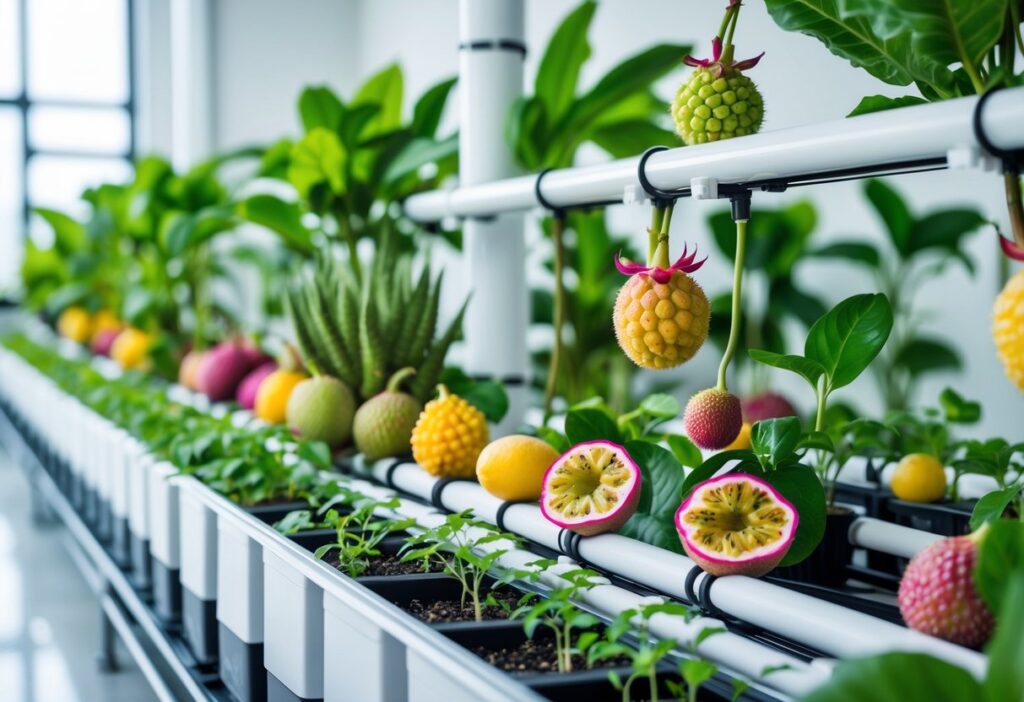
An exotic fruit hydroponic system allows growers to cultivate fruits like mangoes, pineapples, and dragon fruit without soil. This method uses nutrient-rich water solutions to support plant growth in a controlled environment.
The system helps control temperature, humidity, and light, making it possible to grow fruits year-round regardless of outside weather. This is useful for tropical fruits that usually need specific climates.
Hydroponics uses less water than traditional farming, which is important for sustaining delicate exotic fruits. It also reduces the risk of soil-borne diseases, improving plant health.
Choosing the right system type and nutrient mix is essential for success. Different fruits have different needs, so growers must adjust conditions carefully.
More details on how to grow tropical and exotic fruits hydroponically can be found in this guide to hydroponic growing techniques for tropical and exotic fruits.
16) Aquaponic Combo Garden

An aquaponic combo garden blends hydroponics and aquaculture. It uses fish to provide natural nutrients for plants growing in water, creating a balanced system.
Fish waste breaks down into nutrients, feeding the plants. In return, the plants filter and clean the water for the fish. This cycle reduces the need for added fertilizers.
This method works well in small spaces and indoors. It allows gardeners to grow fresh vegetables and raise fish simultaneously. The system can be simple or more advanced depending on the setup.
Combining these two methods can improve efficiency and sustainability. It offers a hands-on way to learn about ecosystems while producing food year-round. For more ideas and tips, see aquaponic garden ideas for experts.
Key Benefits of Hydroponic Gardening
Hydroponic gardening offers practical advantages that improve plant growth, save resources, and maximize available space. These benefits make it a strong choice for both beginners and experienced growers.
Water Conservation
Hydroponic systems use significantly less water than traditional soil gardening. Water is recirculated within the system, reducing waste and evaporation. This reuse can cut water usage by up to 90%.
Because roots access water directly, there’s no need for excess watering. This precision helps protect plants from overwatering issues common in soil gardens.
Water conservation is especially important in dry regions or places with limited water access. This system helps growers maintain productive gardens while using water more efficiently.
Faster Plant Growth
Plants in hydroponic setups grow faster due to direct nutrient delivery. Nutrients dissolve in water and reach plant roots immediately, bypassing soil barriers. This leads to quicker and more efficient nutrient absorption.
Growth rates can increase by 30-50% compared to soil gardening. Oxygen is also more available at the roots, supporting healthier development.
Faster growth means earlier harvests, which benefits gardeners looking to produce more in less time. This efficiency supports continuous cropping cycles and better food production.
Space Efficiency
Hydroponic gardening requires less land area to grow the same amount of produce. Plants can be grown vertically or stacked, using upward space instead of spreading out horizontally.
This approach suits small spaces like apartments, balconies, and urban settings. Vertical systems allow for higher yields shown in compact areas.
Because plants receive precise nutrients and water, density can increase without risking overcrowding. More food can be grown in less room, making hydroponics ideal for limited-space environments.
For more ideas, explore the benefits of hydroponic gardening.
Choosing the Right Hydroponic System
Selecting a hydroponic system depends on factors like plant type, available space, and ease of use. Each system has specific setups, lighting needs, and maintenance routines that affect plant growth and project success.
Nutrient Film Technique vs. Deep Water Culture
The Nutrient Film Technique (NFT) uses a thin layer of nutrient solution flowing over plant roots. This method suits small, fast-growing plants like leafy greens. It requires a slight slope to keep the water moving and good root aeration. NFT systems use less water and nutrients but depend on a steady pump and clean channels to avoid blockages.
Deep Water Culture (DWC) keeps roots submerged in oxygenated nutrient-rich water. It is ideal for larger plants such as tomatoes or peppers. DWC systems need reliable air pumps to oxygenate the water and can better handle plant growth spurts. However, water temperature and oxygen levels must be carefully checked to prevent root damage.
Lighting Considerations
Lighting is vital in hydroponics, especially for indoor setups without natural sunlight. LED grow lights are popular due to low heat output and energy efficiency. Light intensity and duration should match the plant species and growth stage. For example, seedlings need lower light intensity, while flowering plants need higher.
Positioning lights properly ensures even coverage and avoids burned leaves. Color spectrum also matters; blue light encourages vegetative growth, and red light supports flowering. Programmable timers help maintain consistent light cycles, mimicking natural day-night rhythms.
Maintenance Requirements
Hydroponic systems vary in how much care they need. NFT and DWC both require routine checks of pH and nutrient levels to keep water quality optimal. Monitoring pump functionality is critical to prevent plant stress or death.
Cleaning is essential to avoid algae and bacterial buildup, especially in channels or reservoirs. Systems with fewer moving parts generally need less daily oversight but still require weekly thorough cleanings. Beginners might prefer simpler setups with straightforward maintenance tasks to reduce errors.
Regular inspections and water changes help maintain a healthy root environment and steady plant growth. For tips on choosing the right system based on your skill level and goals, see this guide on comparing hydroponic systems.
Frequently Asked Questions
Successful hydroponic gardening depends on proper setup, plant choice, and managing common challenges. Cost efficiency and seed selection are also important to maintain a thriving system. Understanding these factors helps avoid common pitfalls.
How can I set up a DIY indoor hydroponic garden?
Setting up a DIY indoor hydroponic garden starts with selecting a system like the NFT Hydroponic Tower, DIY PVC Pipe Garden, or Kratky Method.
They need a clean space with enough light or grow lights, a reservoir for nutrient solution, and a way to hold plants in place. Proper water quality and pH balance are crucial.
Which plants are ideal for growing in an indoor hydroponic system?
Leafy greens like lettuce, spinach, and kale do well indoors. Herbs such as basil, mint, and parsley also grow quickly.
Tomatoes, strawberries, and peppers are other good options but require more light. These plants fit well with systems like the Nutrient Film Technique (NFT) Setup.
What are some common challenges when managing an outdoor hydroponic garden?
Temperature fluctuations and pest control are common issues outdoors. Nutrient concentration needs close monitoring.
Outdoor systems like Floating Raft or NFT setups may face algae growth and water evaporation. Consistent maintenance is necessary to prevent these problems.
What is the most cost-effective plant to grow in a hydroponic system?
Leafy greens such as lettuce and herbs like basil tend to be the most cost-effective. They grow fast and have a high yield in small spaces.
These plants require less nutrient input and are easier to manage, making them ideal for beginners or small-scale growers.
How do I choose the best seeds for my indoor hydroponics setup?
Select seeds known for fast germination and strong growth in hydroponic conditions. Look for varieties bred for indoor or greenhouse use.
He or she should buy from reliable seed suppliers to ensure high germination rates and healthy plants.
What are the noteworthy disadvantages of using hydroponics for gardening?
Hydroponic systems require regular monitoring of nutrient levels, pH, and water quality. Power outages or equipment failures can harm plants quickly.
Startup costs can be higher than soil gardening. Some plants do not adapt well to hydroponic growth, limiting variety.
